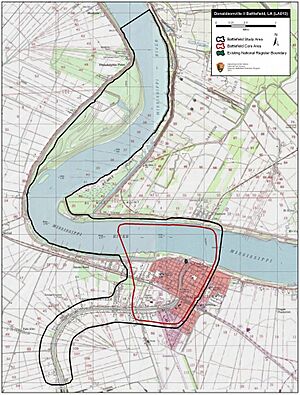Second Battle of Donaldsonville facts for kids
Quick facts for kids Second Battle of Donaldsonville |
|||||||
|---|---|---|---|---|---|---|---|
| Part of the American Civil War | |||||||
|
|||||||
| Belligerents | |||||||
| Commanders and leaders | |||||||
| Joseph D. Bullen | Tom Green | ||||||
| Units involved | |||||||
| 28th Maine USS Winona (1861) USS Princess Royal |
Tom Green's Texas Brigade James Patrick Major's Texas Brigade |
||||||
| Strength | |||||||
| 2 companies 2 gunboats |
2 brigades | ||||||
| Casualties and losses | |||||||
| 23 | 301 | ||||||
The Second Battle of Donaldsonville was an important fight during the American Civil War. It happened on June 28, 1863, in a place called Ascension Parish, Louisiana. This battle was a big win for the Union side.
Contents
Why the Battle Happened
On June 28, 1863, a Confederate general named Alfred Mouton gave an order. He wanted two groups of soldiers, led by General Tom Green and Colonel James Patrick Major, to capture the town of Donaldsonville, Louisiana.
But before they could take the town, the Confederates had to capture Fort Butler, Louisiana. This fort was built by the Union army and was protecting the area.
Who Fought in the Battle
The Union soldiers defending Fort Butler were from the 28th Maine Volunteer Infantry. There were two companies of them, along with some soldiers who were recovering from injuries.
The Confederate forces were much larger. They included General Tom Green's Texas Brigade and Colonel James Patrick Major's Texas Brigade. A "brigade" is a large group of soldiers.
The Battle Begins
On the night of June 27, General Green's Confederate troops moved close to Fort Butler. They were ready to attack. The attack started just after midnight.
The Confederate soldiers quickly surrounded the fort. They tried to get past the barriers the Union had put up. Some Confederate troops attacked along a raised path called a levee. But they ran into a wide ditch they didn't know about. This ditch was too wide to cross, and it helped the Union defenders a lot.
A Union warship, the USS Princess Royal, also came to help. It started firing its cannons at the attacking Confederates. The Confederates kept trying to break through, but their attacks didn't work. Eventually, they gave up and left.
What Happened After
Because of this battle, the Union army kept control of this important spot on the Mississippi River. Many other towns along the Mississippi River were also controlled by the Union. The Confederates could bother these Union areas, but they couldn't get rid of them.
Soldiers and Ships Involved
Union Forces
- 28th Maine Volunteer Infantry Regiment
- Company C
- Company F
- Company G
- Other soldiers recovering from injuries
- USS Princess Royal - Led by Commander Melancthon Brooks Woolsey
- USS Winona (1861) - Led by Lieutenant Commander A.W. Weaver
Confederate Forces
- 3rd Regiment Arizona Battalion
- 3rd Texas Cavalry - Led by Colonel Joseph Phillips
- 4th Texas Cavalry - Led by Colonel W.P Hardeman
- 5th Texas Cavalry - Led by Major Denman Shannon
- 7th Texas Cavalry - Led by Colonel Philemon Herbert
- 1st Texas Partisan Rangers - Led by Colonel Walter P. Lane
- 2nd Texas Partisan Rangers - Led by Lieutenant Colonel R.P. Crump
- 1st Louisiana Battery - Led by Lieutenant O. Semmes


